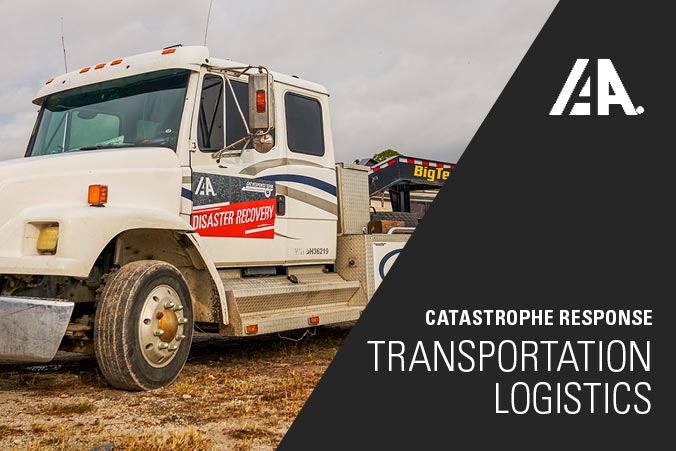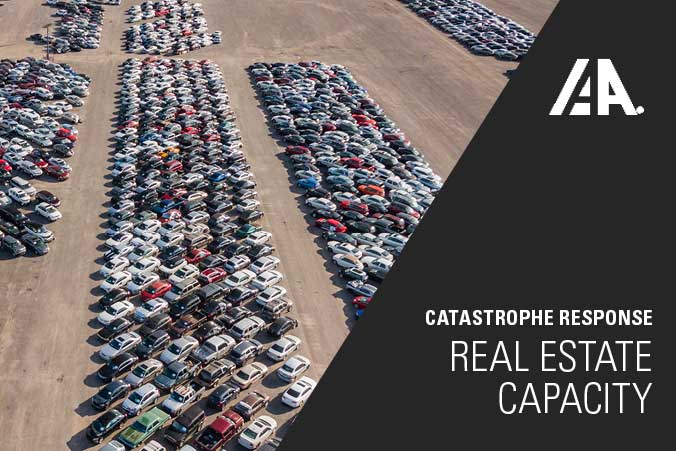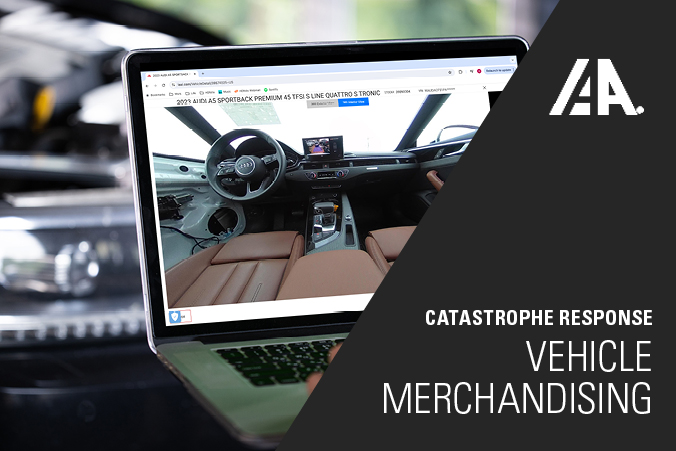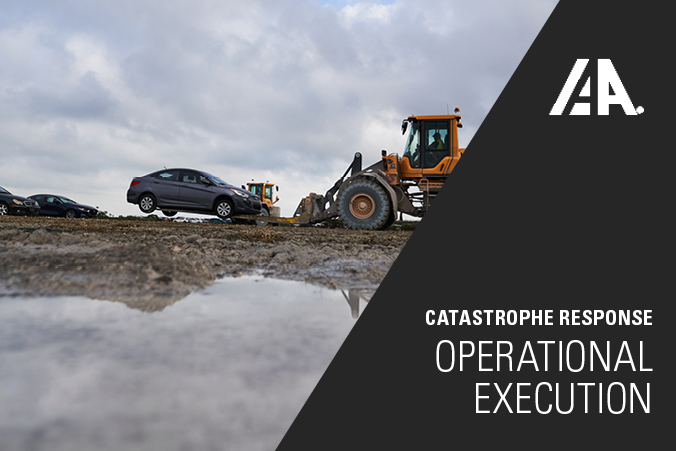Catastrophe Response
IAA Catastrophe Response Strategy: Transportation Logistics
Published June 7, 2024 - Written by IAA, Inc.
10 Min read
Summary
IAA’s Catastrophe Response Strategy is sound and scalable, enabling us to respond to the unpredictability, size and frequency of any weather event, including having exceptional transportation logistics to handle each CAT event.
Overview
When the unexpected happens, a swift recovery is critical to ensure business continues and communities get b
ack on their feet. IAA’s Catastrophe Response Strategy is sound and scalable, enabling us to respond to the unpredictability, size and frequency of any weather event. Because these catastrophe events, such as wildfires, hurricanes and tornadoes, have many shifting variables, a proactive yet flexible process is necessary to ensure a timely and appropriate response.
IAA’s Catastrophe Response Strategy provides an unmatched level of service to our customers in their greatest time of need. It comprises four key areas: Real Estate Capacity, Operational Execution, Transportation Logistics and Vehicle Merchandising. Here, we dive deeper into Transportation Logistics.


The most significant challenges when planning to retrieve thousands of vehicles impacted by a catastrophic weather event are the unknowns. This includes an important question: What level of towing resources are needed to respond effectively?
Beyond the simple execution of moving a large number of vehicles quickly and efficiently after a CAT event, a Transportation Logistics Strategy must start with an effective capability to forecast demand and translate that into a quantifiable amount of resources. Securing the right resources is the only way to meet the needs and concerns of providers, their policyholder customers, and IAA’s own tower network.
IAA addresses these transportation and logistics challenges with industry-leading innovation, preparation and execution. Decades of catastrophe-specific data allow IAA to forecast the demand for towing resources based on various event types. Our demand models help secure the right resources and deploy them to the right location, at the right time. This results in a highly efficient towing operation that reduces cycle times, increases response reliability and efficiency, and allows providers to better manage increased claim volumes. It also provides towers with an efficient, seamless and productive experience.
IAA’s primary commitment is to transport customers’ vehicle assets quickly, safely, and efficiently to our facilities. This is particularly important during catastrophic events when impacted vehicle volumes can dramatically surge. By digitizing and automating a historically cumbersome, paper-driven assignment process, our towing partners maintain productivity, and can seamlessly manage their assignments, routes and loads. IAA’s preparation around Transportation Logistics focuses on four key areas:
Initial Response Capability
Nationwide Tower Network
Logistics Technology
Scalable Release Process Administration

Initial Response Capability
IAA developed our Initial Response tower network to ensure transportation service immediately following a CAT event. Our Initial Response tower network includes a broad network of trucks that understands the urgency of getting to affected areas quickly.
In addition to the Initial Response tower network capability, IAA’s nationwide tower network provides the capacity and flexibility to effectively manage an influx of vehicles after a catastrophic event, regardless of where it occurs. We accomplish this by continuously investing in our tower network and fostering strong relationships with our towing providers.
A key component in building those relationships is our collaborative approach, built around the logistics principle of on-time performance. Each third-party IAA towing company is fully contracted with IAA and agrees to service level and delivery standards. All vehicles moving through the IAA logistics system include a delivery expectation, and our towers are evaluated according to their delivery performance. In addition, our tower network utilizes our logistics technology, including the Auto Dispatch feature from the IAA Tow App™, to provide a seamless, efficient, productive experience for towers.
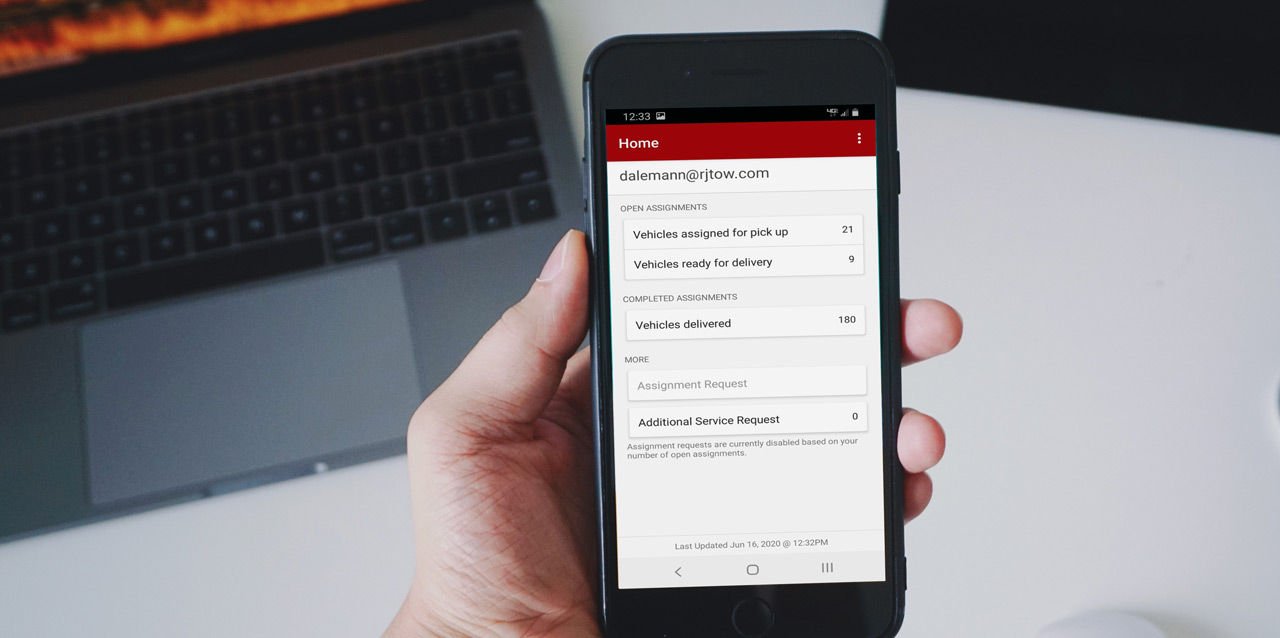
IAA actively works to provide towers with significant operational benefits, including:
Density to fill out truck capacities
Inbound and outbound tow assignments for increased efficiency
Wait-free, automated dispatching
Paperless and seamless processes
Real-time data on vehicles, drop-off times, locations, and log notes
Nationwide Tower Network
IAA views Transportation Logistics within our business model as two facets: day-to-day operations and catastrophe. When a catastrophic event occurs, focus increases in affected areas. However, operations and on-time performance must continue across all of our 210+ facilities. To continue seamless day-to-day operations, we maintain a separate network of towers for catastrophe response.
We are continually building relationships within the towing industry to provide the resources needed to manage the transport needs arising from any size catastrophe event. This collaborative relationship approach increases the reliability of IAA’s towing resources, a competitive advantage beyond simply owning tow trucks.
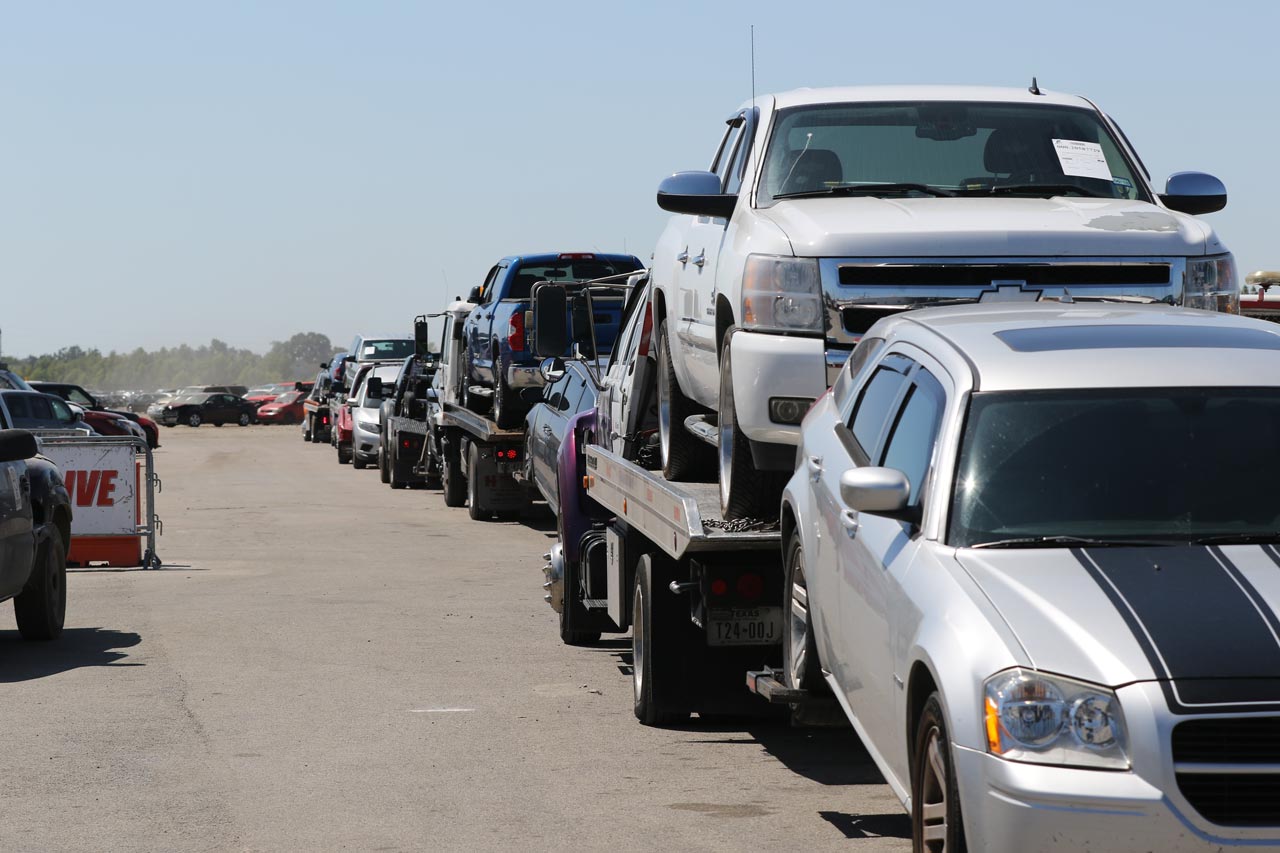
One of the most critical issues in Transportation Logistics is balancing day-to-day transport needs with catastrophe assistance. Company-owned towing assets support day-to-day operations. When a catastrophe happens and those assets move to manage the resulting surge in vehicle volume, the day-to-day or standard transportation needs must be backfilled. Quickly acquiring additional assistance for day-to-day operations can prove to be challenging and expensive if there is a lack of a consistent relationships within the towing industry. IAA’s approach of maintaining consistent relationships with the towing industry enables our day-to-day operations to continue without disruption.
Logistics Technology
IAA’s innovative technology effectively and efficiently distributes towing resources in advance of a storm or catastrophe in several keyways:
Automated method to secure commitments from CAT trucks to service an event
Auto-deployment of trucks to catastrophic event
IAA Auto Dispatch technology through the IAA Tow App™ connects available towers to available tow assignments, automatically
Easy to use functionality allowing drivers to quickly complete the entire transport process via the app — from location, to pick up, to check-in, to drop-off at an auction facility or holding yard
Increased tower participation in the network by including part-time resources

Auto Dispatch connects available towers to tow assignments, automatically. It makes working with IAA seamless for contracted towers, eliminating paperwork requirements and using technology to speed up the payment process.
Scalable Release Process Administration
IAA’s centralized contact center model, with redundant capability across multiple sites, provides the advantage of scalable resources to process vehicles and catastrophe assignments. Our contact center resources utilize structured labor management systems that deploy appropriate resources to handle volume spikes caused by catastrophes. When demand increases, our centralized contact centers can quickly scale. This scalability accelerates the logistics process from assignment, to release, to dispatch and towing while driving increased policyholder satisfaction.
IAA Transportation Logistics: Competitive Advantages
IAA has consistently delivered the industry’s leading catastrophe service and response in all CAT events that have occurred since Hurricane Sandy in 2012.
Industry-exclusive Auto Dispatch technology within the IAA Tow App™ can significantly shorten cycle times, and increase efficiencies for our insurance clients, their policyholders, and the towing industry.
Scalable, centralized contact centers provide significant flexibility and resources to speed all transportation-related processes, including vehicle assignments, releases, dispatch and towing.
Investment in resources to develop and maintain relationships within the towing industry provides the resources and flexibility to manage any sized catastrophic event.
Focus on towing industry relationships provides the right level of resources in the right locations in both catastrophe situations as well as day-to-day operations.
Transportation Logistics alone cannot manage a catastrophe. IAA’s Catastrophe Response Strategy consists of four components including Transportation Logistics, Operational Execution, Real Estate Capacity and Product Service Support – an unmatched portfolio of capabilities
Forward-Looking Statements
Certain statements contained in this release include “forward-looking statements” within the meaning of Section 27A of the Securities Act of 1933 (the “Securities Act”) and Section 21E of the Securities Exchange Act of 1934 (the “Exchange Act”) and Canadian securities laws. Forward-looking statements are typically identified by such words as “aim”, “anticipate”, “believe”, “could”, “continue”, “estimate”, “expect”, “intend”, “may”, “ongoing”, “plan”, “potential”, “predict”, “will”, “anticipates”, “should”, “would”, “could”, “likely”, “generally”, “future”, “long-term”, “foresees”, “estimates”, “opportunity” or the negative of these terms, and similar expressions intended to identify forward-looking statements. Forward-looking statements are based on current expectations and assumptions that are subject to risks and uncertainties that may cause actual results to differ materially. These statements are based on our current expectations and estimates about our business and markets, and may include, among others, statements relating to IAA’s Catastrophe Response Strategy, our future strategy, objectives, targets, projections and performance and other statements that are not historical facts. It is uncertain whether any of the events anticipated by the forward-looking statements will transpire or occur, or if any of them do, what impact they will have on the results of operations and financial condition of the combined companies or the price of RB Global’s common shares. Therefore, you should not place undue reliance on any such statements, and caution must be exercised in relying on forward-looking statements. While RB Global’s management believes the assumptions underlying these forward-looking statements are reasonable, these forward-looking statements involve certain risks and uncertainties, many of which are beyond RB Global’s control, that could cause actual results to differ materially from those indicated in such forward-looking statements, including but not limited to: our results of operations, strategy and plans; potential adverse reactions or changes to our business or employee relationships; our ability to integrate acquisitions (including IAA, Inc. ), the diversion of management time on transaction-related issues; the ability of RB Global to retain and hire key personnel and employees; the significant costs associated with the merger; the outcome of any legal proceedings that could be instituted against RB Global; changes in capital markets and the ability of the company to generate cash flow and/or finance operations in the manner expected or to de-lever in the timeframe expected; the failure of RB Global to meet financial forecasts and/or KPI targets; legislative, regulatory and economic developments affecting the business of RB Global; general economic and market developments and conditions; the evolving legal, regulatory and tax regimes under which RB Global operates; unpredictability and severity of catastrophic events, including, but not limited to, pandemics, acts of terrorism or outbreak of war or hostilities, as well as RB Global’s response to any of the aforementioned factors. Other risks that could cause actual results to differ materially from those described in the forward-looking statements are included in RB Global’s periodic reports and other filings with the Securities and Exchange Commission (“SEC”) and/or applicable Canadian securities regulatory authorities, including the risk factors identified under Part I, Item 1A “Risk Factors” in RB Global’s most recent Annual Report on Form 10-K for the year ended December 31, 2023. The forward-looking statements included in this release are made only as of the date hereof. While the list of factors presented here is considered representative, no such list should be considered to be a complete statement of all potential risks and uncertainties. Many of these risk factors are outside of our control, and as such, they involve risks which are not currently known that could cause actual results to differ materially from those discussed or implied herein. RB Global does not undertake any obligation to update any forward-looking statements to reflect actual results, new information, future events, changes in its expectations or other circumstances that exist after the date as of which the forward-looking statements were made, except as required by law.
